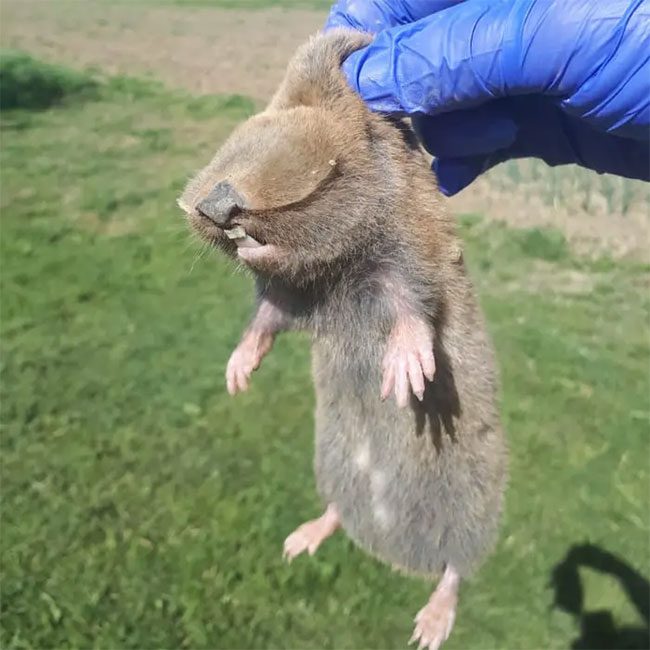The naked mole rat is a species distributed from Southeast Europe to Iran. This species is an important subject in medical research aimed at extending human lifespan and enhancing cancer resistance.
Our world is filled with strange and fascinating creatures. Occasionally, you may encounter or read about a species that leaves you wondering whether their appearance is cute, endearing, or downright terrifying! The naked mole rat is one such creature that can put you in such a dilemma.
The naked mole rat belongs to the family Spalacidae and has two distinct subspecies: the lesser naked mole rat (Spalax leucodon) and the larger naked mole rat. They are primarily found in the eastern Mediterranean and Black Sea regions, from the Balkans across Ukraine, Asia Minor, Syria, Palestine, and into Egypt and Libya. These underground rodents are covered by dense fur, appear to have no ears and no eyes, with large teeth protruding from their mouths.

The naked mole rat is an underground rodent covered by dense fur.
Where Are the Naked Mole Rat’s Eyes?
All naked mole rats, as their name suggests, are blind. But that does not mean this species lacks eyes. In fact, they are not completely blind and possess quite rudimentary eyes, with a diameter of about 1 mm located beneath their skin and fur. However, these eyes serve a very different purpose compared to human eyes. The eyes of the naked mole rat can only detect light. Studies have shown that removing these eyes disrupts their perception of light cycles.
Thermoregulation, reproduction, and hibernation—all these behaviors are vital for mammals, requiring them to recognize changes in light cycles. Therefore, the small eyes of the naked mole rat have an important function in helping them understand their surroundings. The retina of their non-functional eyes contains photoreceptor cells that can collect the faint light that penetrates the ground, thus functioning like a light meter.

The eyes of the naked mole rat are located beneath the skin and fur.
The Naked Mole Rat: A Research Subject for Its Cancer Resistance
Naked mole rats do not develop cancer because their cells can self-terminate through a toxic protein when they proliferate rapidly. They can live up to 20 years, which is at least 10 times longer than a similarly sized mouse. Their cancer resistance may explain, to some extent, this longevity.
In fact, a study also found that all naked mole rats can tolerate very high doses of chemotherapy with minimal side effects. Scientists hope that if they can learn more about how exactly these naked mole rats achieve this resistance, it may lead to the development of a cancer treatment for humans that harnesses the beneficial aspects without causing any harm.

Naked mole rats can tolerate very high doses of chemotherapy with minimal side effects.
Other Interesting Facts
1. Naked Mole Rats Do Not Use Claws to Dig Burrows
Most burrowing rodents use their claws to dig tunnels, but these little friends do not. All naked mole rats use their heads, snouts, and primarily their mouths to create complex underground mazes of tunnels.
They have large incisors that act like chisels and powerful jaw muscles, allowing them to dig through soil that weighs up to ten times their body weight.

2. Naked Mole Rats Can Live in Near-Zero Oxygen Conditions
Naked mole rats can survive in extremely low oxygen conditions. They can endure up to five hours at an oxygen level as low as 3%. According to research, they can also exist in an atmosphere with 80% CO2.
It has been observed that when oxygen levels are extremely low, naked mole rats enter a state of metabolism similar to hibernation, and their heart rates drop significantly. However, when oxygen is restored, they can fully recover and continue their activities as if nothing had happened.
Scientists studying hairless mole rats believe that they survive without oxygen by essentially turning themselves into plants—of course, not literally. Other mammals, including us, break down glucose to produce energy, but this process requires oxygen, and without it, brain cells begin to die! However, mole rats have a high content of fructose and sucrose in their bodies, along with GLUT5, a molecule that can transport fructose into their cells. Consequently, they use fructose sugar for energy instead of breaking down glucose.

Naked mole rats can assist archaeologists in excavating historical sites.
3. Israeli Archaeologists Believe Naked Mole Rats Could Become Valuable Helpers in Excavations
Israeli archaeologists believe that naked mole rats could be capable members of their team to help excavate historical sites. It may sound like a funny suggestion, but in reality, this species is an excellent digger and can move soil weighing nearly ten times their body weight.
Thus, if trained, they could assist archaeologists in unearthing historical artifacts from underground. Additionally, by systematically studying the dirt from naked mole rats, archaeologists could gain a fairly accurate idea of the areas they should focus on during excavations.
Honestly, naked mole rats are strange, unique creatures that continue to intrigue scientists with their biological characteristics.


















































